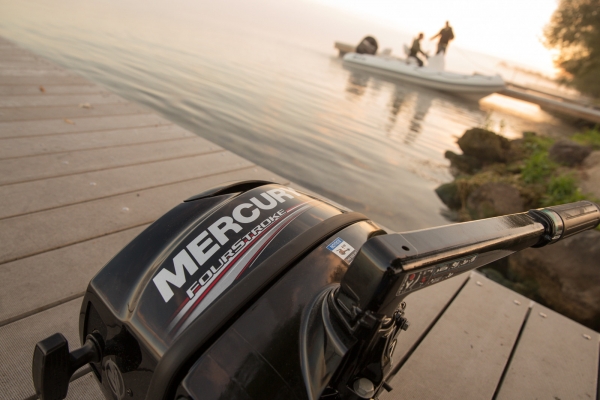Usually one of the first things I ask is "tiller or remote?". What I mean by asking this is whether you need an outboard that steers right at the motor or one that uses a steering wheel. Tiller steer models are the motors that have the handle or arm attached to the motor. These are typically used on smaller to mid-sized fishing boats. They are also popular as a secondary motor or "kicker motor" on fishing boats for trolling at slower speeds. Remote steer models are controlled by a steering wheel and use a control box for shifting and throttle speed. You can find remote models as low as 9.9hp from all the major manufacturers.
The next thing I usually ask a customer is "short or long". This refers to the length of motor your boats transom requires. There are four different sizes of boat transoms and in turn four different sizes of outboards. The four outboard sizes are 15" short shaft, 20" long shaft, 25" extra long shaft, and 30" ultra long shaft. The two most common ones you will see on your local inland lakes are the short and long shaft. The other two sizes are pretty much for big water rigs that run larger bodies of water such as the Great Lakes or the ocean. Short shaft motors are for boats with a transom roughly around 15" and are typically around 14 foot in length or smaller. Most company's make a short shaft motor up to about 50hp. Your long shaft motor will be on a boat that has a transom anywhere from 17- 22 inches. These are typically your deep-v fishing boats, bass boats, pontoons, and speed boats. Long shaft motors are manufactured from 3.5hp and up. Making sure you get the right length motor is crucial.
Lastly I will ask "whats your max?" and I'm not talking about your budget here. Im asking what the max horsepower rating is for your boat. Knowing this and where to find it is kind of important. Every boat now a days has a yellow coast guard tag either at the back of the boat or near the console. This tag will tell you the maximum horsepower rating, maximum person capacity, and maximum weight load. If your looking for performance I wouldn't go less than 2/3 of what your max is. If you go any lower you will really start to see a lack in performance. Although on the other hand, some people just need a motor to putts around the lake. Usually a 9.9hp or so on their 16 foot pontoon suites these boaters just fine. I also ask this question because like most marina's, we will not repower a boat over its max horsepower rating.
Lets say we have determined that you need a remote, long shaft model on your boat. This is were I start getting into what rigging components or "control box" you need. The control box is the unit that controls the speed and shifting of the motor. There are a few different styles such as side mount, concealed side mount, and binnacle. The side mount is most common and mounts to either the side of your console or the boat. A concealed side mount is the same thing except the mechanical workings are concealed and the shift/throttle lever is the only thing showing. You may need a separate key switch with these but they do make for a much cleaner look. Lastly is the binnacle mount control box. These are mounted right on top of the console near the steering wheel. You typically see these on larger boats or boats with multiple engines. Knowing what style is already on your boat will help when repowering, but If not the dealer can help you come to a conclusion.
Knowing the difference between two and four stroke outboards is not a huge deal, but there are some big differences between them. Most used motors you run across are going to be two stroke and pretty much everything brand new will be a four stroke, aside from the ETEC and a few manufacturers making select two-stroke models. Four strokes usually have an age range from the mid 1990's to present. These motors are quieter, don't need a gas/oil mix, better on fuel, heavier than a two stroke, and cost more. Two strokes have an age range from the 60' and 70's to present. They are more common to see for sale since they have been around in the outboard industry longer than the four stroke technology. These motors are a little louder, need a gas/oil mixture, lighter in weight, and cheaper than a comparable four stroke.
These are the typical terms and questions I find the novice boater to be unfamiliar with. Which is perfectly fine, but being prepared and having an understanding of what you have and what you need makes the whole experience a lot less complicated and confusing.


